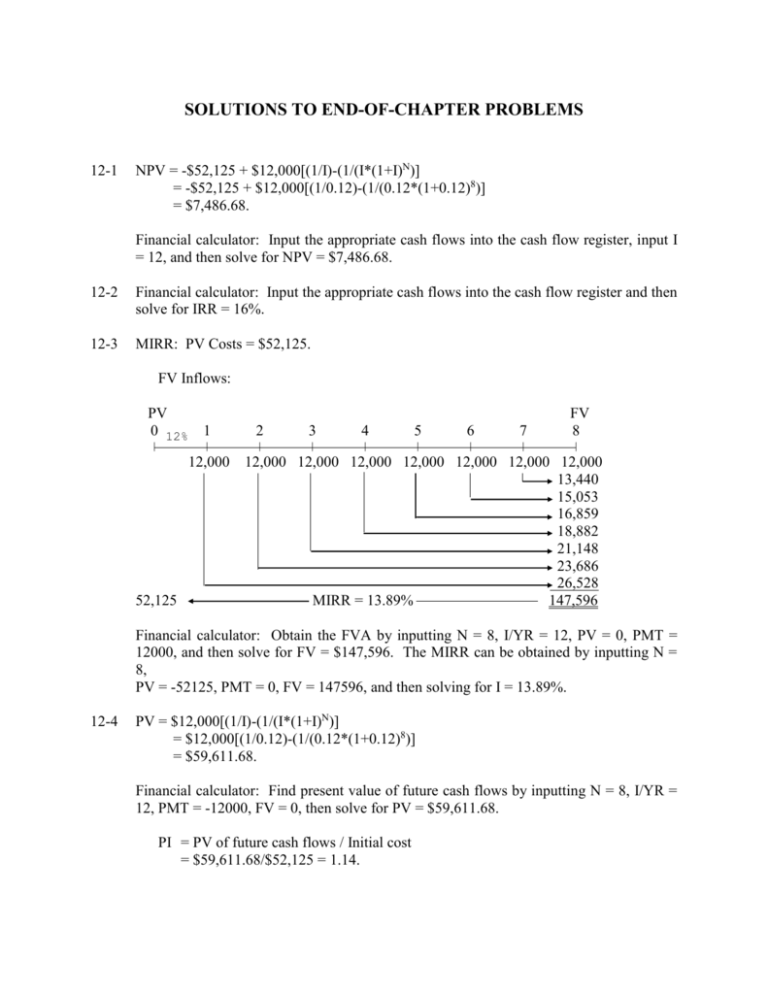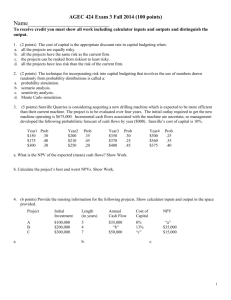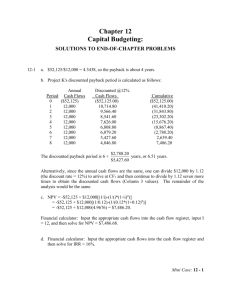Finance Problem Solutions: NPV, IRR, MIRR, Payback
advertisement

SOLUTIONS TO END-OF-CHAPTER PROBLEMS 12-1 NPV = -$52,125 + $12,000[(1/I)-(1/(I*(1+I)N)] = -$52,125 + $12,000[(1/0.12)-(1/(0.12*(1+0.12)8)] = $7,486.68. Financial calculator: Input the appropriate cash flows into the cash flow register, input I = 12, and then solve for NPV = $7,486.68. 12-2 Financial calculator: Input the appropriate cash flows into the cash flow register and then solve for IRR = 16%. 12-3 MIRR: PV Costs = $52,125. FV Inflows: PV 0 12% | 1 2 3 4 5 6 7 FV 8 | | | | | | | | 12,000 52,125 12,000 12,000 12,000 12,000 12,000 12,000 12,000 13,440 15,053 16,859 18,882 21,148 23,686 26,528 MIRR = 13.89% 147,596 Financial calculator: Obtain the FVA by inputting N = 8, I/YR = 12, PV = 0, PMT = 12000, and then solve for FV = $147,596. The MIRR can be obtained by inputting N = 8, PV = -52125, PMT = 0, FV = 147596, and then solving for I = 13.89%. 12-4 PV = $12,000[(1/I)-(1/(I*(1+I)N)] = $12,000[(1/0.12)-(1/(0.12*(1+0.12)8)] = $59,611.68. Financial calculator: Find present value of future cash flows by inputting N = 8, I/YR = 12, PMT = -12000, FV = 0, then solve for PV = $59,611.68. PI = PV of future cash flows / Initial cost = $59,611.68/$52,125 = 1.14. 12-5 Year 0 1 2 3 4 5 6 7 8 CF -52,125 12,000 12,000 12,000 12,000 12,000 12,000 12,000 12,000 Cumulative CF -52,125 -40,125 -28,125 -16,125 -4,125 7,875 19,875 31,875 43,875 The cumulative cash flows turns positive in Year 5, so the payback will be 4 plus the part of Year 5 that is required to return the investment: Payback = 4 + ($4,125/$12,000) = 4.34. Because the future cash flows are identical, we can also find the payback period by dividing the cost by the cash flow: $52,125/$12,000 = 4.34. 12-6 The project’s discounted payback period is calculated as follows: Year Annual CF 0 1 2 3 4 5 6 7 8 -52,125 12,000 12,000 12,000 12,000 12,000 12,000 12,000 12,000 Discounted CF (@12%) The discounted payback period is 6 + 12-7 $10,714.29 $9,566.33 $8,541.36 $7,626.22 $6,809.12 $6,079.57 $5,428.19 $4,846.60 $2,788.11 years, or 6.51 years. $5,428.19 Project A: Using a financial calculator, enter the following: CF0 = -15000000 CF1 = 5000000 CF2 = 10000000 CF3 = 20000000 Cumulative Discounted CF -52,125.00 (41,410.71) (31,844.39) (23,303.02) (15,676.81) (8,867.69) (2,788.11) 2,640.08 7,486.68 I/YR= 10; NPV = $12,836,213. Change I/YR = 10 to I/YR = 5; NPV = $16,108,952. Change I/YR = 5 to I/YR = 15; NPV = $10,059,587. Project B: Using a financial calculator, enter the following: CF0 = -15000000 CF1 = 20000000 CF2 = 10000000 CF3 = 6000000 I/YR = 10; NPV = $15,954,170. Change I/YR = 10 to I/YR = 5; NPV = $18,300,939. Change I/YR = 5 to I/YR = 15; NPV = $13,897,838. 12-8 Truck: NPV = -$17,100 + $5,100(PVIFA14%,5) = -$17,100 + $5,100(3.4331) = -$17,100 + $17,509 = $409. (Accept) Financial calculator: Input the appropriate cash flows into the cash flow register, input I/YR = 14, and then solve for NPV = $409. Financial calculator: Input the appropriate cash flows into the cash flow register and then solve for IRR = 14.99% ≈ 15%. MIRR: PV Costs = $17,100. FV Inflows: PV 0 14% | 1 2 3 | | | 5,100 17,100 5,100 5,100 MIRR = 14.54% (Accept) 4 | 5,100 FV 5 | 5,100 5,814 6,628 7,556 8,614 33,712 Financial calculator: Obtain the FVA by inputting N = 5, I/YR = 14, PV = 0, PMT = 5100, and then solve for FV = $33,712. The MIRR can be obtained by inputting N = 5, PV = -17100, PMT = 0, FV = 33712, and then solving for I/YR = 14.54%. Pulley: NPV = -$22,430 + $7,500(3.4331) = -$22,430 + $25,748 = $3,318. (Accept) Financial calculator: Input the appropriate cash flows into the cash flow register, input I/YR = 14, and then solve for NPV = $3,318. Financial calculator: Input the appropriate cash flows into the cash flow register and then solve for IRR = 20%. MIRR: PV Costs = $22,430. FV Inflows: PV 0 | 14% 1 2 3 4 | | | | 7,500 22,430 7,500 7,500 MIRR = 17.19% (Accept) 7,500 FV 5 | 7,500 8,550 9,747 11,112 12,667 49,576 Financial calculator: Obtain the FVA by inputting N = 5, I/YR = 14, PV = 0, PMT = 7500, and then solve for FV = $49,576. The MIRR can be obtained by inputting N = 5, PV = -22430, PMT = 0, FV = 49576, and then solving for I/YR = 17.19%. 12-9 Electric-powered: NPVE = -$22,000 + $6,290 [(1/i)-(1/(i*(1+i)n)] = -$22,000 + $6,290 [(1/0.12)-(1/(0.12*(1+0.12)6)] = -$22,000 + $6,290(4.1114) = -$22,000 + $25,861 = $3,861. Financial calculator: Input the appropriate cash flows into the cash flow register, input I/YR = 12, and then solve for NPV = $3,861. Financial calculator: Input the appropriate cash flows into the cash flow register and then solve for IRR = 18%. Gas-powered: NPVG = -$17,500 + $5,000 [(1/i)-(1/(i*(1+i)n)] = -$17,500 + $5,000 [(1/0.12)-(1/(0.12*(1+0.12)6)] = -$17,500 + $5,000(4.1114) = -$17,500 + $20,557 = $3,057. Financial calculator: Input the appropriate cash flows into the cash flow register, input I/YR = 12, and then solve for NPV = $3,057. Financial calculator: Input the appropriate cash flows into the cash flow register and then solve for IRR = 17.97% ≈ 18%. The firm should purchase the electric-powered forklift because it has a higher NPV than the gas-powered forklift. The company gets a high rate of return (18% > r = 12%) on a larger investment. 12-10 Financial calculator solution, NPV: Project S Inputs 5 12 N I Output PV 3000 0 PMT FV 7400 0 PMT FV = -10,814.33 NPVS = $10,814.33 - $10,000 = $814.33. Project L Inputs 5 12 N I Output PV = -26,675.34 NPVL = $26,675.34 - $25,000 = $1,675.34. Financial calculator solution, IRR: Input CF0 = -10000, CF1 = 3000, Nj = 5, IRRS = ? IRRS = 15.24%. Input CF0 = -25000, CF1 = 7400, Nj = 5, IRRL = ? IRRL = 14.67%. Financial calculator solution, MIRR: Project S Inputs 5 12 0 3000 N I PV PMT Output FV = -19,058.54 PV costsS = $10,000. FV inflowsS = $19,058.54. Inputs 5 N Output I = 13.77 MIRRS = 13.77%. -10000 0 19058.54 PV PMT FV Project L Inputs 5 12 0 7400 N I PV PMT FV -25000 0 47011.07 PV PMT FV Output = -47,011.07 PV costsL = $25,000. FV inflowsL = $47,011.07. Inputs 5 N Output I = 13.46 MIRRL = 13.46%. PIS = $10,814.33 $26,675.34 = 1.081. PIL = = 1.067. $10,000 $25,000 Thus, NPVL > NPVS, IRRS > IRRL, MIRRS > MIRRL, and PIS > PIL. The scale difference between Projects S and L result in the IRR, MIRR, and PI favoring S over L. However, NPV favors Project L, and hence L should be chosen. 12-11 Project X: 0 12% | -1,000 1 2 3 | | | | 100 300 400 700.00 448.00 376.32 140.49 1,664.81 1,000 4 13.59% = MIRRX` $1,000 = $1,664.81/(1 + MIRRX)4. Project Y: 0 12% | -1,000 1 2 3 4 | | | | 50 50.00 56.00 125.44 1,404.93 1,636.37 1,000 1,000 100 13.10% = MIRRY $1,000 = $1,636.37/(1 + MIRRY)4. Thus, since MIRRX > MIRRY, Project X should be chosen. Alternative step: You could calculate NPVs, see that Project X has the higher NPV, and just calculate MIRRX. NPVX = $58.02 and NPVY = $39.94. 12-12 a. Purchase price Installation Initial outlay $ 900,000 165,000 $1,065,000 CF0 = -1065000; CF1-5 = 350000; I = 14; NPV = ? NPV = $136,578; IRR = 19.22%. b. Ignoring environmental concerns, the project should be undertaken because its NPV is positive and its IRR is greater than the firm's cost of capital. c. Environmental effects could be added by estimating penalties or any other cash outflows that might be imposed on the firm to help return the land to its previous state (if possible). These outflows could be so large as to cause the project to have a negative NPV--in which case the project should not be undertaken. 12-13 a. NPV ($) 1,000 900 800 700 600 500 Project A 400 300 200 Project B Cost of Capital (%) 100 -100 5 10 15 20 25 30 -200 -300 r 0.0% 10.0 12.0 18.1 20.0 24.0 30.0 NPVA $890 283 200 0 (49) (138) (238) NPVB $399 179 146 62 41 0 (51) b. IRRA = 18.1%; IRRB = 24.0%. c. At r = 10%, Project A has the greater NPV, specifically $283.34 as compared to Project B's NPV of $178.60. Thus, Project A would be selected. At r = 17%, Project B has an NPV of $75.95 which is higher than Project A's NPV of $31.05. Thus, choose Project B if r = 17%. d. Here is the MIRR for Project A when r = 10%: PV costs = $300 + $387/(1.10)1 + $193/(1.10)2 + $100/(1.10)3 + $180/(1.10)7 = $978.82. TV inflows = $600(1.10)3 + $600(1.10)2 + $850(1.10)1 = $2,459.60. Now, MIRR is that discount rate which forces the TV of $2,459.60 in 7 years to equal $978.82: $952.00 = $2,547.60(1+MIRR)7. MIRRA = 14.07%. Similarly, MIRRB = 15.89%. At r = 17%, MIRRA = 17.57%. MIRRB = 19.91%. e. To find the crossover rate, construct a Project ∆ which is the difference in the two projects' cash flows: Project ∆ = Year CFA - CFB 0 $105 1 (521) 2 (327) 3 (234) 4 466 5 466 6 716 7 (180) IRR∆ = Crossover rate = 14.53%. Projects A and B are mutually exclusive, thus, only one of the projects can be chosen. As long as the cost of capital is greater than the crossover rate, both the NPV and IRR methods will lead to the same project selection. However, if the cost of capital is less than the crossover rate the two methods lead to different project selections--a conflict exists. When a conflict exists the NPV method must be used. Because of the sign changes and the size of the cash flows, Project ∆ has multiple IRRs. Thus, a calculator's IRR function will not work. One could use the trial and error method of entering different discount rates until NPV = $0. However, an HP can be "tricked" into giving the roots. After you have keyed Project Delta's cash flows into the g register of an HP-10B, you will see an "Error-Soln" message. Now STO IRR/YR STO IRR/YR to obtain IRR = 456.22%. Similarly, Excel or Lotus 1-2-3 can also be used. 12-14 a. Incremental Cash Year 0 1 2-20 Plan B ($10,000,000) 1,750,000 1,750,000 Plan A ($10,000,000) 12,000,000 0 Flow (B - A) $ 0 (10,250,000) 1,750,000 If the firm goes with Plan B, it will forgo $10,250,000 in Year 1, but will receive $1,750,000 per year in Years 2-20. b. If the firm could invest the incremental $10,250,000 at a return of 16.07%, it would receive cash flows of $1,750,000. If we set up an amortization schedule, we would find that payments of $1,750,000 per year for 19 years would amortize a loan of $10,250,000 at 16.0665%. Financial calculator solution: Inputs 19 N I Output -10250000 1750000 0 PV PMT FV = 16.0665 c. Yes, assuming (1) equal risk among projects, and (2) that the cost of capital is a constant and does not vary with the amount of capital raised. d. See graph. If the cost of capital is less than 16.07%, then Plan B should be accepted; if r > 16.07%, then Plan A is preferred. NPV (Millions of Dollars) 25 B 20 15 Crossover Rate = 16.07% 10 A IRRB = 16.7% IRRA = 20% 5 5 10 15 20 25 Cost of Capital (%) 12-15 a. Financial calculator solution: Plan A Inputs 20 10 N I/YR Output PV 8000000 0 PMT FV = -68,108,510 NPVA = $68,108,510 - $50,000,000 = $18,108,510. Plan B Inputs 20 10 N I/YR Output PV 3400000 0 PMT FV = -28,946,117 NPVB = $28,946,117 - $15,000,000 = $13,946,117. Plan A Inputs 20 N Output I/YR -50000000 8000000 0 PV PMT FV -15000000 3400000 0 PV PMT FV = 15.03 IRRA = 15.03%. Plan B Inputs 20 N Output I/YR = 22.26 IRRB = 22.26%. b. If the company takes Plan A rather than B, its cash flows will be (in millions of dollars): Cash Flows Cash Flows Project ∆ Year from A from B Cash Flows 0 ($50) ($15.0) ($35.0) 1 8 3.4 4.6 2 8 3.4 4.6 . . . . . . . . . . . . 20 8 3.4 4.6 So, Project ∆ has a "cost" of $35,000,000 and "inflows" of $4,600,000 per year for 20 years. Inputs 20 10 N I/YR PV 4600000 0 PMT FV Output = -39,162,393 Inputs NPV = $39,162,393 - $35,000,000 = $4,162,393. 2 -35000000 4600000 N I/YR PV PMT 0 FV Output = 11.71 IRR = 11.71%. Since IRR∆ > r, and since we should accept ∆. This means accept the larger project (Project A). In addition, when dealing with mutually exclusive projects, we use the NPV method for choosing the best project. c. NPV (Millions of Dollars) 125 A Crossover Rate = 11.7% 100 B 75 IRRA = 15.03% 50 IRRB = 22.26% 25 5 10 15 20 25 30 Cost of Capital (%) -25 IRR = 11.7% -50 d. The NPV method implicitly assumes that the opportunity exists to reinvest the cash flows generated by a project at the cost of capital, while use of the IRR method implies the opportunity to reinvest at the IRR. If the firm's cost of capital is constant at 10 percent, all projects with an NPV > 0 will be accepted by the firm. As cash flows come in from these projects, the firm will either pay them out to investors, or use them as a substitute for outside capital which costs 10 percent. Thus, since these cash flows are expected to save the firm 10 percent, this is their opportunity cost reinvestment rate. The IRR method assumes reinvestment at the internal rate of return itself, which is an incorrect assumption, given a constant expected future cost of capital, and ready access to capital markets.









